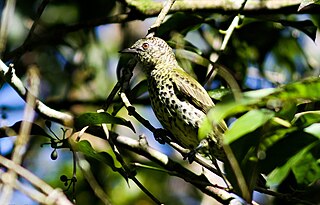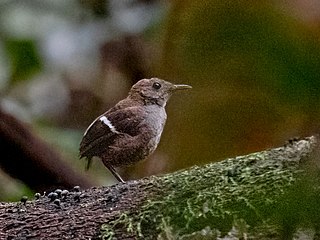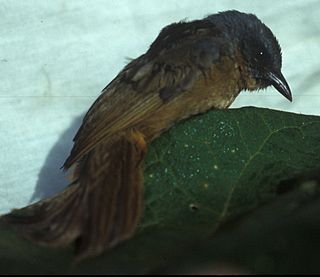
Wrens are a family, Troglodytidae, of small brown passerine birds. The family includes 96 species and is divided into 19 genera. All species are restricted to the New World except for the Eurasian wren that is widely distributed in the Old World. In Anglophone regions, the Eurasian wren is commonly known simply as the "wren", as it is the originator of the name. The name wren has been applied to other, unrelated birds, particularly the New Zealand wrens (Acanthisittidae) and the Australian wrens (Maluridae).

The sharpbill is a small passerine bird in the family Tityridae. Its range is from the mountainous areas of tropical South America and southern Central America.

Philip Lutley Sclater was an English lawyer and zoologist. In zoology, he was an expert ornithologist, and identified the main zoogeographic regions of the world. He was Secretary of the Zoological Society of London for 42 years, from 1860 to 1902.

The peppershrikes are two species of passerine bird found in tropical Central and South America. They form the genus Cyclarhis, part of the vireo family.

The olive-faced flatbill or olive-faced flycatcher is a species of bird in the tyrant flycatcher family Tyrannidae. It is found in riparian woodland and at the forest edge in western Amazonia.

The peg-billed finch is a passerine bird endemic to the highlands of Costa Rica and western Panama. Despite its name, it is not a true finch, but now recognized as a member of the tanager family (Thraupidae), after being long placed in the Emberizidae. It is the only member of the genus Acanthidops. The scientific name commemorates the American ornithologist Spencer Fullerton Baird.

The typical spinetails, Cranioleuca, are a genus of Neotropical birds in the ovenbird family Furnariidae.

The wing-banded wren is a species of bird in the family Troglodytidae. It is found in Brazil, Ecuador, French Guiana, Guyana, Peru, Suriname, and Venezuela.

The southern nightingale-wren, also known as the scaly-breasted wren, is a species of bird in the family Troglodytidae. It is found in Bolivia, Brazil, Colombia, Costa Rica, Ecuador, Panama, Peru, and Venezuela.

Myrmoborus is a genus of passerine birds in the antbird family, Thamnophilidae.

The white-crested spadebill is a species of passerine bird in the tyrant flycatcher family Tyrannidae. It is found in Bolivia, Brazil, Colombia, Ecuador, French Guiana, Guyana, Peru, Suriname, and Venezuela. Its natural habitat is subtropical or tropical moist lowland forests.

Polioptila is a genus of small insectivorous birds in the family Polioptilidae. They are found in North and South America.

Pygochelidon is a genus of birds in the swallow family Hirundinidae that occur in the Neotropics.

The golden-naped tanager is a species of bird in the tanager family Thraupidae. It is found in South America from Colombia to Bolivia. Its natural habitats are subtropical or tropical moist montane forests and heavily degraded former forest.

The dusky-throated antshrike is a species of bird in subfamily Thamnophilinae of family Thamnophilidae, the "typical antbirds". It is found in Bolivia, Brazil, Colombia, Ecuador, French Guiana, Guyana, Peru, Suriname, and Venezuela.

Sphenopsis is a genus of warbler-like birds in the tanager family Thraupidae. They are found in highland forest of South America.

The northern chestnut-breasted wren is a species of passerine bird in the wren family Troglodytidae that is found in central Colombia, Ecuador and northern Peru. It was formerly considered as a subspecies of the chestnut-breasted wren now renamed the southern chestnut-breasted wren.

Taczanowski's brushfinch is a species of passerine bird in the New World sparrow family Passerellidae. It is found in montane forest and woodland of central Peru. It was formerly considered to be a subspecies of the slaty brushfinch.


















